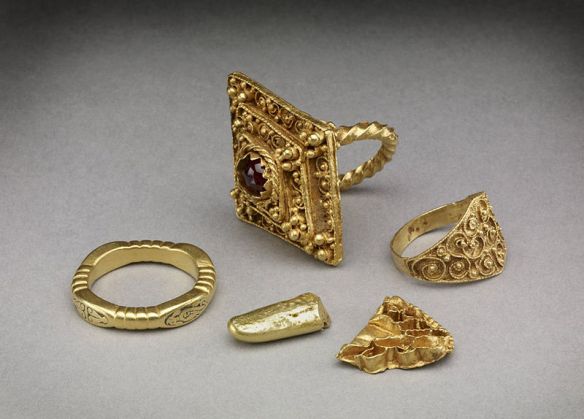
Image found at “Hoard of Anglo-Saxon rings” by portableantiquities – http://www.flickr.com/photos/finds/7549067512/in/set-72157630526828120. Licensed under CC BY 2.0 via Commons – https://commons.wikimedia.org/wiki/File:Hoard_of_Anglo-Saxon_rings.jpg#/media/File:Hoard_of_Anglo-Saxon_rings.jpg
Once again turning to the blog of the website First Things, I found a post by Peter J. Leithart. In this post, entitled “Beowulfian Chiasms,” he briefly explains the idea that as a whole, Beowulf is structured like many concentric rings.
To clarify just what a chiasm is (something I know I needed): a “chiasm” is a literary device in which ideas are presented alongside complements in a concentric pattern. So if you took a work that used chiasm in its structure you could represent that as A,B,A’,B’ (much like how rhyme scheme gets mapped out with letters of the alphabet).
Getting back to Beowulf, there are actions in the poem that are more or less symmetrically opposite one another and that are closely related enough that they form a set of concentric rings (the ring visual makes the most sense if you understand both references to be opposite points on the same ring). Among the examples that Leithart gives are Beowulf’s fight with Grendel, in which Grendel rejoices to start the fight off and Beowulf rejoices at its end, and the Danes hearing an uproar in Heorot and being terrified and then their hearing more uproar and being terrified again (after Bewoulf manages to get a good grip on Grendel). Since it’s such a quick and enlightening read, I highly recommend that you go over and visit this post.
Reading what else Leithart had to say about Bewoulf as a poem with a chiastic structure deeply intrigued me. In particular, after explaining how the structure works in Beowulf, Leithart points out that the fight with Grendel’s mother is at the center of everything since that’s where Beowulf comes closest to dying.
I definitely think that the fight with Grendel’s mother is of great importance to the poem and the story of Bewoulf, even setting aside the possible reference to Christ’s harrowing hell after dying on the cross that Leithart points to as the major significance of the event. I find extreme meaning in this passage outside of the potential religious reference because, for me, the fight with Grendel’s mother is the only fight in the whole poem that pits Beowulf against something that is the most opposed to him and what he represents.
Yeah, a lot of this opposition does come down to Grendel’s mother being a woman, but I think that Leithart’s point about Grendel’s mother representing a society that’s more matriarchal and family-centric than the Danes’ patriarchal and hall society-centric one is very strong (from this post). As such, Beowulf isn’t just fighting some monster that might be stronger than him, he’s fighting something that’s just about entirely opposed to him in every way possible.
Because of the seriousness of this fight, his being near death as Grendel’s mother tries to stab him isn’t just Beowulf’s closest scrape with death, but the moment in the poem where the old school matriarchy (monstrous in the eyes of the patriarchal church and society of the time) directly butts up against the newly reinvigorated patriarchy (of course represented by a place like Heorot where rulers are generous, food and drink are plentiful, and people revel in Christianized stories of the past).
I also felt my heart flutter when Leithart drew comparisons between Beowulf and the Aeneid and the Odyssey, two epic poems that also have a visit to the underworld at their centres. The thought that the poet behind Beowulf could have known these stories (the Aeneid would have been around in Latin, and it’s possible, as far as I know, that a Latin translation of the Odyssey could also have been accessible) and yet they resisted building off of them is astounding. Especially since they’re both stories that involve a lot of sea-faring adventure, of which Beowulf has a bit. But that adventuring on the open sea is kept to the background in favour of creating a story that’s more focussed on battle, storytelling, and remembering (and retelling) the past.
To be honest, though, just having the Beowulf poet in the same group as Virgil and Homer respectively makes Beowulf all the more amazing to me.
Which fight in Beowulf do you think is the most important? Why?

I’ve always interpreted Beowulfs descent into the mere to fight Grendels Mother as an example of Katabasis: The delving down into the murky waters of the collective human psyche in order to face our “demons”. As such, I find this particular battle to be the most intriguing in the tale.
LikeLiked by 1 person
Thanks for the comment, Megas! Even though it’s not the last fight, I definitely think it’s the fiercest. So I think it definitely lines up the best with fighting our inner demons. For a patriarchal society, putting those demons into a woman’s form makes Jungian sense, too.
LikeLiked by 1 person
Indeed, the realm of the subconscious has often been associated with the feminine. In Celtic myth the entrance to the Otherworld (often located near a pool) is usually guarded by a Goddess. I wrote an analysis of Beowulf myself about a year ago, but even now I find new insights. It’s the myth that keeps on giving.
LikeLiked by 1 person